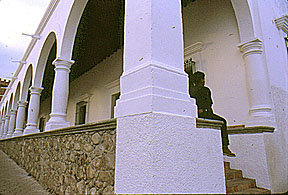Sonora--Mexico's
Wild West
by Bob Brooke
 The
Charm of Alamos The
Charm of Alamos
Spanish conquistador Coronado visited this Sonoran colonial town set in
the foothills of the Sierra Madre Occidental in 1531 but settlement
didn't occur until silver was discovered in 1663. It was originally
named ‘Real de los Frailes" (Mining camp of the friars),
referring to two nearby peaks that resemble monks.
At its peak, Alamos was the wealthiest
town in Sonora–miners extracted over $500 million worth of silver from
nearby mines over 200 years--and attracted immigrants from all over the
Pacific, including a number of Chinese and Japanese, who founded a silk
factory and were expelled in 1916 for having too much economic power.
The town prospered between 1750 and 1880.
A series of rebellions by Yaqui mine laborers, followed by the 1910-20
revolution, brought all mining to a halt by the 1920s–the town quickly
declined.
Today, Alamos has about 6,000 residents,
many of them expatriate North Americans who have restored the charming
Sonoran-style casas wrapped around interior courtyards in the center of
town. But Alamos has managed to hold onto a traditional feel partially
because of, rather than in spite of, the gringo presence. Around 250
Americans and Canadians have houses here but fewer than a dozen live
here year-round.
I found the expat group in Alamos
different from their San Carlos counterparts. Although most gringo
homeowners reside only in winter, many take the time to learn Spanish
and support the town's cultural events.
I decided to go for a walk before dinner.
Homeowners sweep the streets of Alamos' cleaner than anywhere else in
Mexico. Declared a National Historic Monument by the Mexican government,
it has no billboards and no neon. Every sign or exterior renovation, in
fact, must be approved as stylistically compatible before being
displayed. Though the entire town can be seen on foot in less than two
hours, I decided to hold off on a more in-depth exploration until the
following day.
But for now, hunger drove me to Los
Palermos, a cozy restaurant overlooking the Plaza de Armas. I sat
outdoors under the portico and watched life on the plaza while I slowly
savored a dish of molcajete stew, a mixture of chicken, onions,
cheese, and green pepper boiled in a pot.
The following I began my tour of Alamos
at the Plaza de Armas, a wide-open square crowned by an ornate, lacy
wrought iron gazebo surrounded by an extensive rose garden rimmed with
royal palms. Old houses, since converted into inns and restaurants, line
its perimeter. At the far end stands La Parroquia de la Purisima
Concepcion, a large stone church completed in 1786 after the Yaqui
destroyed the adobe original in a 1772 uprising. At the opposite end is
the compact Museo Costumbrista de Sonora, a small museum containing
historic exhibits on Alamos mining, including a room plastered to look
like a mine interior.
Adjacent to it stands Plaza Alameda a
lovely square shaded by alamos (cottonwood) trees. The
traditional evening promenade usually takes place here.
The City of Alamos is over three hundred
and seventy years old and one of the best preserved. In the mid
seventeen hundreds, King Carlos III of Spain sent a surveyor general to
map out the city streets. Mansions were built by prospering silver
barons.
I found the many restored homes to be
simple, imposing, block-like, single-story structures with grand
entryways and tall, iron-grilled windows–at least from the outside.
The most elaborate of them feature portales, sheltered walkways
featuring Doric columns, topped with Roman arches. However, behind the
facades, the houses follow a U-shaped or L-shaped plan around flower
bedecked central courtyards. Since all of these houses are private
residences, the only way to view them is to purchase an $8 ticket for
the weekly House and Garden tours given each Saturday morning.
After soaking up the Old Mexico
atmosphere Alamos, I headed over to Ciudad Obregon to drop my rental car
and fly home.
<<Previous
Page |

